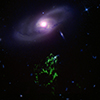CXC Home | Search | Help | Image Use Policy | Latest Images | Privacy | Accessibility | Glossary | Q&A
Tour of IC 2497
Quicktime MPEG
Citizen science projects have done some remarkable things in recent years and those in astronomy are no exception. One of the early success stories of the Galaxy Zoo citizen science project was the discovery of an unusual object in 2007. This object was found by Hanny van Arkel who, at the time, was a school teacher in the Netherlands. Today, the object is known as "Hanny's Voorwerp," which means "Hanny's object" in Dutch.
Professional astronomers have also taken an interest in Hanny's Voorwerp. This unusually-shaped cloud of gas, which also has another nickname of the "green blob," is located only about 200,000 light years from the galaxy IC 2497. While this sounds like a huge distance, it is actually very close in cosmic terms. Because of that, Hanny's Voorwerp is affected by what goes on in IC 2497, in particular by the behavior of the giant black hole at its center. In fact, the green blob gets its color because oxygen atoms in the gas cloud have been excited by the incoming ultraviolet and X-ray radiation from regions close to the black hole.
Even though astronomers suspect this black hole was a so-called quasar in the past, recent Chandra observations indicate that it has since faded. So far, Hanny's Voorwerp shows no sign of dimming, but with the 200,000 light year separation, astronomers in the upcoming millennia might just see the lights in the green blob start to flicker off.
New observations with Chandra suggest that the black hole is still producing large amounts of energy even though it is no longer generating intense radiation as a quasar. The X-ray data suggest that jets powered by the black hole have blown a large bubble in surrounding gas. This shows that giant black holes can have a big effect on their environments.
[Runtime: 03:00]
Quicktime MPEG
Citizen science projects have done some remarkable things in recent years and those in astronomy are no exception. One of the early success stories of the Galaxy Zoo citizen science project was the discovery of an unusual object in 2007. This object was found by Hanny van Arkel who, at the time, was a school teacher in the Netherlands. Today, the object is known as "Hanny's Voorwerp," which means "Hanny's object" in Dutch.
Professional astronomers have also taken an interest in Hanny's Voorwerp. This unusually-shaped cloud of gas, which also has another nickname of the "green blob," is located only about 200,000 light years from the galaxy IC 2497. While this sounds like a huge distance, it is actually very close in cosmic terms. Because of that, Hanny's Voorwerp is affected by what goes on in IC 2497, in particular by the behavior of the giant black hole at its center. In fact, the green blob gets its color because oxygen atoms in the gas cloud have been excited by the incoming ultraviolet and X-ray radiation from regions close to the black hole.
Even though astronomers suspect this black hole was a so-called quasar in the past, recent Chandra observations indicate that it has since faded. So far, Hanny's Voorwerp shows no sign of dimming, but with the 200,000 light year separation, astronomers in the upcoming millennia might just see the lights in the green blob start to flicker off.
New observations with Chandra suggest that the black hole is still producing large amounts of energy even though it is no longer generating intense radiation as a quasar. The X-ray data suggest that jets powered by the black hole have blown a large bubble in surrounding gas. This shows that giant black holes can have a big effect on their environments.
[Runtime: 03:00]
(Credit: NASA/CXC/A. Hobart)
Return to IC 2497 (Aug 10, 2016)



